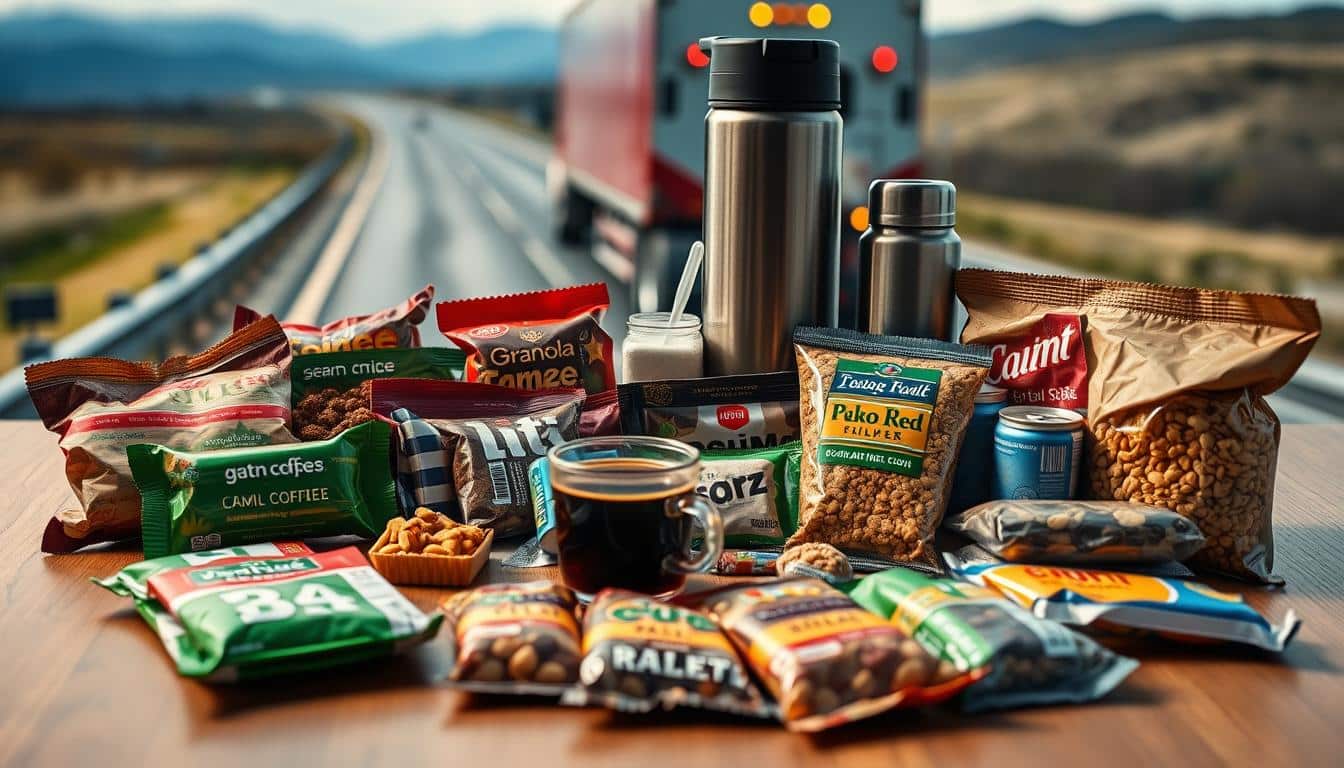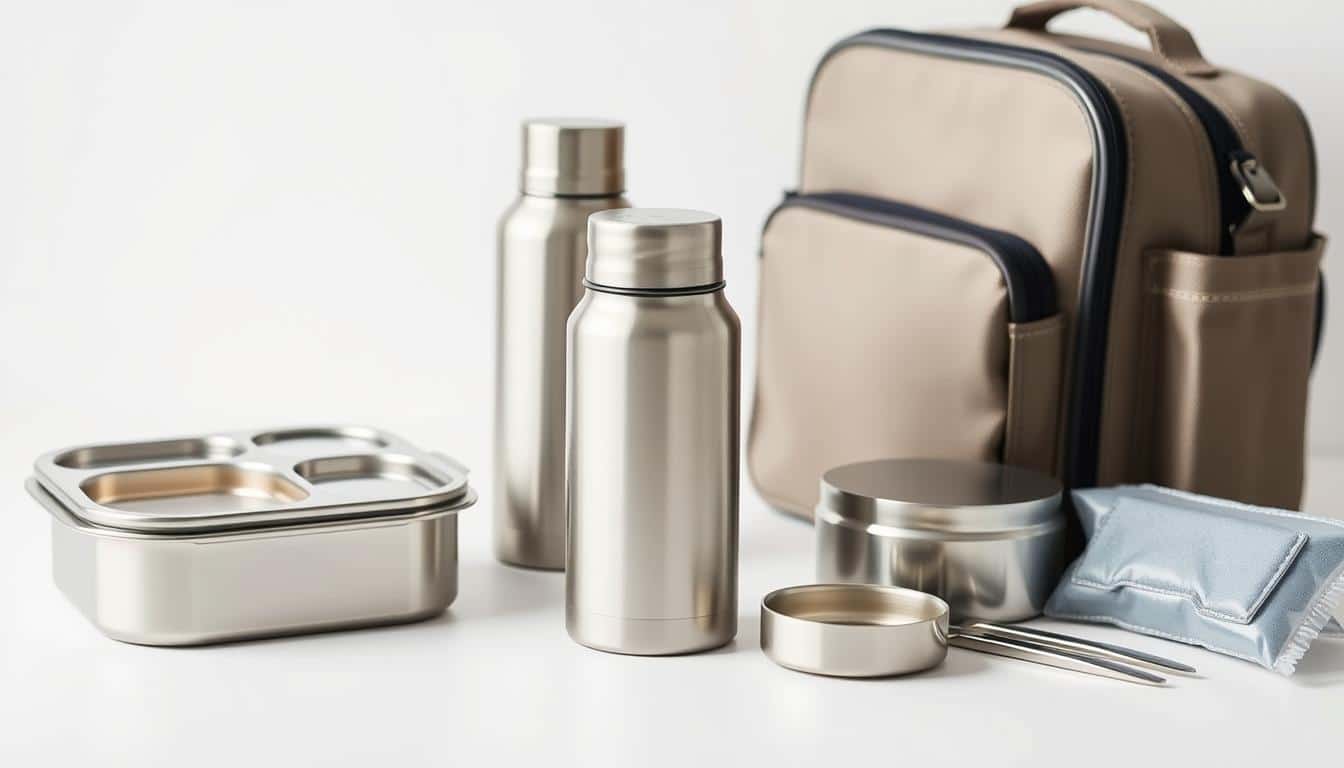Life on the road changes your sleep, movement, and eating habits. Drivers at places like Swift Transportation face long hours without much access to kitchens. This makes it hard to eat well every day.
Eating right can help truck drivers avoid health issues like obesity and heart disease. Starting the day with protein, having fiber-rich meals, and lean meats can boost energy. It also helps drivers stay fit while traveling.
Bringing your own food and planning when to buy groceries can help. Try packing snacks like hard-boiled eggs, Greek yogurt, and fruits. These items, along with drinking water and eating the right amounts, keep drivers sharp and healthy during trips.
Why Nutrition Matters for Truck Drivers’ Health
Good food keeps truck drivers sharp during long shifts. It affects their energy, mood, and health. Smart eating at rest stops can make a big difference over time.
Impact of poor diet on chronic disease risk
Poor eating habits can lead to chronic diseases. Gaining weight, having high blood pressure, and high cholesterol are big risks. Processed foods and too much salt can increase blood pressure.
Eating foods with bad fats raises the risk of heart issues. Sugary foods and drinks can lead to diabetes. Foods high in sugar harm your teeth over time.
Bad eating habits can cause tooth decay, weak bones, and some kinds of cancer. Making small changes in eating habits can reduce these risks for truck drivers.
Calorie burn vs. calorie intake for drivers (Bureau of Labor Statistics data)
Truck drivers don’t burn as many calories as people in active jobs. They sit for long hours, which means they don’t need as many daily calories. Eating high-calorie foods quickly adds more calories than they burn.
Keeping calories in check helps avoid weight gain and keeps energy levels steady. Picking healthier foods, like lean meats and whole grains, helps balance calories. These choices also make driving safer.
Mental wellbeing, alertness and crash risk linked to nutrition
Eating well helps drivers stay alert. Foods high in sugar can mess with their energy and focus. Not drinking enough water or eating well can cause tiredness and headaches.
Eating better supports a driver’s mood and their ability to make quick decisions. Companies like Swift Transportation see that health programs make drivers safer. Being in good mental health lowers the risk of accidents and helps drivers handle stress better.
Common Diet-Related Conditions in Trucking
Long hours driving and stops at convenience stores impact truck drivers’ health. CDC research shows many suffer from obesity and metabolic issues. Sitting too much, eating at random times, and little room for fresh food lead to unhealthy choices.
Overweight and obesity prevalence among drivers
- According to the CDC, 69% of truck drivers are overweight, and 88% might face diet-related health issues.
- Long hours sitting can lead to high cholesterol and heart disease.
- Small changes, like preparing simple meals, can help avoid high-calorie fast food.
High blood pressure and high cholesterol from processed food and sodium
- Truck stops often have food that’s high in salt, raising blood pressure and stressing the heart.
- Eating a lot of fried food and snacks can make cholesterol levels worse.
- Choosing healthier options like turkey and fresh veggies can help manage sodium and fat intake.
Type 2 diabetes, tooth decay, osteoporosis and other risks
- Eating too much sugar and refined carbs can lead to diabetes and weight issues.
- Sweet drinks and snacks can cause cavities and gum problems, which drivers might not pay attention to.
- Not getting enough calcium and vitamin D, or eating too much junk food, can harm bones and increase osteoporosis risk.
- Bad eating habits can also increase the risk for various cancers and lower overall health on the road.
Many trucking companies, like Swift Transportation, have wellness programs to tackle these issues. Simple actions, such as buying durable produce, cooking in bulk, and choosing foods low in sodium and sugar, can make a big difference.
Healthy Truck Driver Meals
Good food keeps drivers alert and steady on long shifts. Use simple templates that fit a small fridge and a single-burner or microwave. Pack items that travel well, offer steady energy, and resist spoilage.
Breakfast that travels:
- Hard‑boiled eggs or an egg bake cut into slices for quick protein.
- Muffins made with oats, mashed banana, and a scoop of protein powder.
- No‑bake energy bites with oats, peanut butter, flaxseed, and honey for portable breakfast ideas.
- Overnight oats with Greek yogurt and berries to boost protein without morning prep.
Lunch ideas for steady fuel:
- Salads in jars layered with greens, beans, grilled chicken, and a whole‑grain base for healthy truck lunches.
- Tuna or chicken salad on whole‑grain bread or in lettuce wraps to add fiber and lean protein meals.
- Turkey burger patties with tomato, lettuce, and a side of roasted sweet potato for satiety.
- Hearty bean soup or chicken soup kept warm in a thermos when a stove isn’t available.
Dinners that reheat well:
- Stuffed peppers or casseroles portioned into containers for reheatable dinners for drivers.
- Roasted chicken or turkey with quinoa and steamed veggies that reheat evenly.
- One‑pot curry or chili made with lean ground beef or turkey, stored in single servings.
- Baked potatoes topped with cottage cheese, beans, or shredded chicken for a simple finish.
Snack choices and timing matter. Eat breakfasts and lunches that combine whole grains, fiber, and protein to curb cravings. Serve dinners at least two hours before rest and walk briefly after eating to aid digestion.
Smart Snack Choices for the Cab
Choosing the right snacks can keep your energy up and mind clear on long drives. Look for snacks with protein, fiber, and little added sugar to prevent energy dips. Go for small, easy-to-carry items that fit your mobile lifestyle.
Low-sugar, high-protein picks
- Hummus with carrot sticks or whole-grain crackers for a tasty, filling snack.
- String cheese and individually wrapped low-moisture Mozzarella for a quick protein fix.
- Beef jerky or turkey jerky with simple ingredients and low sugar for lasting fullness.
- Pre-peeled hard-boiled eggs in a small cooler for an easy protein boost on the go.
Healthy munchies that satisfy crunch cravings
- Mixed nuts—like almonds, pistachios, cashews—in single-serve bags for easy portion control.
- Whole-grain crackers with tuna packets or single-serve nut butter cups for a balanced snack.
- Air-popped popcorn, with a dash of seasoning, as a guilt-free crunchy treat.
Fruit and dried fruit options plus snack storage tips
- Fresh fruits like apples, bananas, oranges, and strawberries are easy to carry and require no prep.
- Dried fruits, such as apricots and dates, are great for long trips but watch the serving size to avoid too much sugar.
- Keep nuts and dried fruits in airtight containers or bags to stay crispy and fresh.
- Use a small cooler or a mini-fridge for perishables like string cheese, yogurt, and eggs to keep them fresh longer.
- Store jerky and non-perishable crackers in easy-to-reach spots to avoid unplanned snack shopping.
To ensure you have the energy for the day ahead, combine protein-rich snacks with whole foods. Planning your snack storage helps turn cravings into healthy choices that boost your wellness and attention on the road.
Meal Prep Strategies for Long Hauls
Planning ahead helps drivers eat better and avoid fast food. A basic meal plan can keep calories and stress low. Set a calorie goal around 2,000 kcal daily and adjust based on your activity.
Make a smart grocery list first. Pick foods that last and mix up fresh, shelf-stable, and frozen options. Choose versatile basics to avoid buying food on a whim.
- Grocery list trucking must-haves: whole-grain wraps, canned beans, Greek yogurt, eggs, pre-washed greens, apples, nuts, and cheese sticks.
- Add long-lasting milk substitutes and easy proteins like smoked salmon or canned tuna.
- Grab small jars of condiments to enhance taste without too much salt.
Cooking in batches saves time and keeps you from fast food. Use a weekend to prepare meals for the week ahead.
- Batch cooking truckers like: breakfast bakes, soups, casseroles, and grain bowls that warm up easily.
- Put meals in Tupperware or glass for simple warming and eating.
- Mark containers with the date and meal type to keep track and reduce waste.
Control portions to manage space and eating habits. Pre-measured meals help you stick to your diet, even on long days.
- Prep with measuring tools to ensure proper portion sizes on trips.
- Prepare small snack bags to prevent mindless eating during drives.
Storing food safely is key to staying healthy. Use a reliable fridge or cooler and check temperatures often.
- Food storage in trucks: keep raw meat away from other foods and use ice packs for freshness.
- Ensure items like yogurt and pre-peeled eggs are kept cold; always rotate stock.
- Use insulated bags for groceries and change out ice packs to keep food cold.
Good meal prep and careful storage help save money and eat healthier. With a solid grocery list and batch cooking, truckers can enjoy better meals and cut down on fast food.
Cooking in a Semi-Truck: Tools and Easy Recipes

Cooking in a semi-truck helps save money and makes eating healthy easier. Drivers need a few tools and some good recipes. This makes it possible to enjoy tasty meals on long trips, while staying safe.
Essential truck kitchen appliances
- 12V slow cooker for stews and oatmeal that finish while parked.
- Small induction cooktop if the truck’s inverter can handle it; faster and cooler than coils.
- Microwave or portable countertop oven for fast reheating meals in truck.
- Electric kettle for instant soups and hot drinks, plus a mini-fridge to store perishables.
- Insulated food containers and BPA-free Tupperware for single-serving portions.
Safety for truck cooking
- Ventilate the cab when cooking to avoid fumes and moisture buildup.
- Secure appliances on non-slip mats and keep cords tidy to prevent trips.
- Avoid open flames; many carriers ban stovetops and propane in the cab.
- Follow company rules and local regulations about cooking on the property.
- Use a food thermometer to check temperatures when reheating meals in truck.
Quick truck-friendly recipes
- Omelets made in a small skillet or microwave with spinach and low-fat cheese.
- Breakfast sandwiches using whole-grain English muffins, egg, and lean turkey.
- Chicken and vegetable one-pan dinners in a slow cooker or induction pan.
- Lettuce wraps or whole-wheat wraps filled with hummus, grilled chicken, and veggies.
- Baked potatoes topped with cottage cheese, salsa, and steamed broccoli.
Heat-and-eat meal ideas
Go for casseroles, soups, and stews that heat up well. Use single-serving containers to make reheating quicker and cut down on leftovers.
- Batch-cook chili or minestrone and freeze in meal-sized portions.
- Prepare grain bowls with quinoa, roasted vegetables, and a lean protein for quick microwave warm-ups.
- Store salads separately from dressings and add cold toppings after reheating other components.
Reheating best practices
- Thaw frozen meals in the fridge or use the microwave’s defrost setting before full reheating.
- Heat to safe internal temperatures and avoid repeated reheating cycles that lower quality and safety.
- Use insulated containers to keep hot foods at safe temperatures during stops.
With the right tools for your truck kitchen, you can make and enjoy fresh food. This helps drivers feel better and have more energy while on the road. A little planning and the right equipment can make a big difference for healthy eating.
Hydration and Beverage Choices for Road Fitness
Staying hydrated is key for drivers. It keeps you alert, helps with joint pain, and improves digestion. Choose drinks wisely for better health and fewer empty calories.
Why water should replace sugary sodas and excess coffee
Sugary sodas add unwanted calories and spike blood sugar. This can mess with your energy levels on the road. Though coffee boosts alertness, too much could lower calcium levels and make you jittery. Water is best to keep you hydrated day in and day out.
Practical tips: insulated bottles, jugs, and refill strategies
- Invest in an insulated water bottle for truck use to keep water cold through long routes. An insulated water bottle truck setup fits in cup holders and stays cool for hours.
- Keep a large reusable jug or Brita pitcher in the cab for easy refills at truck stops and rest areas.
- Bring a case of bottled water as backup when filters are not available. Refill from sinks when safe to avoid buying sugary drinks at convenience stores.
- Add a slice of lime or cucumber for flavor without extra sugar. Homemade juices work in small amounts when whole fruit is scarce.
When to add electrolytes or protein drinks
Adding electrolytes makes sense after sweating a lot or during long, hot shifts. Opt for low-sugar electrolyte mixes and drink them slowly. This helps replace lost sodium and potassium. Protein drinks are good when you can’t get whole-food protein or miss a meal.
Choose protein shakes that are low in sugar and calories. Combine with fruit or nuts for a balanced snack. Keep single-serve mixes handy and watch out for added sugars on labels.
Grocery Shopping Guide for Truck Drivers
Having a smart grocery list helps truck drivers reduce stops and eat healthily. Choose items that fit in a small fridge and don’t get damaged easily. Include fresh produce, deli essentials, pantry must-haves, and snacks to keep you energized.
Produce picks that travel well
- Apples and oranges last long and boost energy quickly.
- Bananas and pre-washed strawberries are great for quick snacks.
- Baby carrots, snap peas, and cherries are perfect crunchy treats.
- Pre-mixed salads stay fresh and add fiber to your diet.
Convenient deli, dairy, and shelf-stable items
- Sliced turkey or roasted chicken are great for sandwiches.
- Individual hummus packs, hard-boiled eggs, and salad cups for quick meals.
- Yogurt, cottage cheese, and cheese offer good protein snacks.
- Dry goods like granola and instant oats keep you full.
- For busy nights, try heat-and-eat meals or premade sandwiches.
Label reading for drivers
Reading labels helps you make healthier choices at stores. Look for sodium in deli meats and soups. Check added sugars in snacks and drinks. Pay attention to calories in each serving.
Practical tips and low-sodium choices
- Pick products with low-sodium options to stay healthy.
- Choose plain Greek yogurt and add fruit to limit sugar.
- Instead of salty packages, go for beans, veggies, and whole grains.
When shopping, focus on fresh produce, a basic grocery list, and some deli items. Always pay attention to labels to manage calories and sodium. This plan helps save time, avoid truck-stop junk food, and maintain a healthy diet on the road.
Portion Control and Calorie Awareness on the Road
Truckers can make long trips easier by managing how much they eat. Simple habits prevent overeating and keep the mind sharp. Steps below teach meal planning, setting calorie limits, and dodging snack traps.

Using BMR estimates to set daily calorie targets
First, use an online tool or a simple formula to find your BMR. This figure is what you need to just exist, without extra activity. Then, adjust this number based on how much you move and plan for any exercise.
Most drivers need about 1,800–2,200 calories a day if they’re not very active. Add more calories if you walk or exercise regularly. Keeping under 2,000 calories usually helps avoid gaining weight.
Practical portioning techniques in limited space
Cook in batches and put each meal in its own container. Learning actual serving sizes is easier with measuring tools at home.
- Put snacks like nuts or granola into small bags, with each bag as one serving.
- Keep meals and snacks visible in the truck to fight off cravings.
- Small plates or lunchboxes can make meals feel more filling.
How to avoid mindless eating while driving or resting
Stop eating while you drive to avoid eating without thinking. Plan to eat during breaks. Drink water to stop snacking out of habit.
Keep snacks like chips or candy out of sight to eat less. If you’re tempted to snack, first see if you’re really thirsty, tired, or just bored.
Combining Nutrition with On-the-Road Fitness
Good fuel and simple movement work great together. Drivers who eat well and exercise lightly face less risk of gaining weight or feeling tired. It’s smart to plan your meals and workouts so they both help you stay energized during long drives.
Short walks and quick workouts
- Take brisk 10–20 minute walks after stops. This can improve your digestion and mood. These walks also enhance fitness for truckers and reduce feeling sluggish after meals.
- Perform quick sets of bodyweight exercises. Do 2–3 rounds of 10 squats, 8–12 lunges per leg, and 6–10 push-ups. These are great exercises for drivers because they can be done in tight spaces without any equipment.
- Use resistance bands for rows and presses. This adds strength training without needing heavy weights. Bands are also easy to carry in your truck.
Scheduling meals and breaks to prevent discomfort
- Plan your meals around mandatory rest breaks. This ensures that eating doesn’t interfere with driving or sleeping times. Proper scheduling can also prevent hurried eating and poor food choices.
- Try to eat at least two hours before going to bed. This can help avoid bloating and promote better sleep while on the road.
- Eat smaller, more frequent meals. This approach helps maintain steady energy levels and makes it easier to stay active after meals.
Simple strength and mobility moves for drivers
- Do seat stretches like neck rolls, shoulder circles, and seated hip openers. These can ease stiffness and improve mobility, especially after sitting for a long time.
- Practice standing calf raises, single-leg balances, and mini squats. These keep your ankles and hips flexible, which helps with getting in and out of the truck.
- End breaks with 3–5 minutes of targeted stretching. Focus on your hamstrings, hip flexors, and thoracic spine. This can lessen muscle soreness and aid your posture.
Remember to drink water before and after exercising. Making small tweaks to your diet and exercise habits can significantly improve your fitness as a trucker. These changes will help you stay healthy, alert, and happy on the road.
Dietary Special Considerations for Truck Drivers
Spending long hours driving means making smart food choices is key. Drivers can cut health risks by picking foods that help with blood pressure, blood sugar, cholesterol, and allergies. Small changes and reading labels can make eating healthier easier on the road.
Managing salt intake
Lots of salt comes from processed and canned goods. It’s best to avoid too much deli meat, canned soups, and truck-stop sandwiches. Try to choose foods with less than 300 mg of sodium per serving by checking Nutrition Facts labels.
- Go for fresh or frozen veggies instead of canned ones.
- Instead of salty snacks, try unsalted nuts or air-popped popcorn.
- Flavor your food with herbs, lemon, and pepper instead of salt.
Options for drivers with diabetes
It’s important to watch your portions, eat whole grains, lean proteins, and snacks with less sugar. Eating balanced can help keep blood sugar steady during drives.
- Have diabetes-friendly meals ready, like grilled chicken wraps with whole-grain tortillas and veggies.
- Keep snacks around that are low in sugar like string cheese, almonds, and eggs.
- Be mindful of fruit and dried fruit portions to keep carbs in check.
Managing high cholesterol
Choose meats that are lean, fish like salmon, and good fats from plants. Nuts and seeds can also be good for your heart in small amounts.
- Pick grilled or baked proteins instead of fried to lower cholesterol.
- Be sparing with olive oil and stay away from trans fats in processed baked goods.
- Healthy fats can come from walnuts, cashews, and just a few Brazil nuts.
Allergy-friendly choices
Drivers with allergies should go for pre-packed, clearly labeled food. Using non-dairy milk and gluten-free options can help avoid reactions and last longer on the road.
- Have allergy-friendly items like hard-boiled eggs, hummus cups, and sealed cheese handy.
- Keep almond or soy milk in single servings for cooking or coffee.
- At truck stops, asking for simple dishes can help avoid allergy issues.
Healthy treats and dessert swaps
Choosing treats thoughtfully can make life on the road sweeter. Opt for desserts that are lower in sugar and controlled in portion to keep on track.
- Try Greek yogurt with berries and some nuts for a healthy dessert.
- Make oat muffins with banana and a bit of honey for sweetness.
- Sometimes, enjoy fat-free ice cream in single servings or a small amount of dried fruit, watching the sugar.
Reading labels, controlling portions, and making simple food swaps can help drivers. Planning helps find low-sodium, diabetes-friendly, low-cholesterol, allergy-friendly food, and treats that are good for you.
Conclusion
Eating right while traveling keeps you sharp and fit. But, it needs planning and smart decisions. Always pack healthy snacks and watch your portion sizes. Understanding food labels is key. Knowing your daily calorie needs helps manage what you eat. Remember, the average truck driver burns about 1,975 calories a day. Eating too much can lead to health issues that many drivers face.
Changing your habits can improve your health on the road. Make a shopping list, cook in batches, and keep food in Tupperware. Having a mini-fridge helps. Choose water over sugary drinks. Cooking your own meals and picking nutritious snacks can decrease your visits to truck stops. This way, your diet stays steady.
Look for support from your company and use resources they offer. Start by preparing your meals, choosing whole foods, and using containers to help with portion control. Set your eating goals based on your basic metabolic rate (BMR). Drinking a lot of water and doing short workouts during stops are good habits. These steps can lead to better health for truck drivers, making healthy eating a consistent part of life on the road.
FAQ
What are practical, protein-rich breakfast options for long hauls?
How can I plan lunches that are filling, travel-friendly, and low in sodium?
What dinner choices work well with limited cab cooking equipment?
Which snacks should I keep in the cab to stay full and alert?
What fruits and dried fruits travel best and how should I store them?
How do I shop and prep to avoid relying on truck-stop food?
What are safe and space-efficient storage tips for perishable foods in the cab?
Which compact appliances are most useful for cooking in a semi-truck?
What quick truck-friendly recipes keep prep and cleanup simple?
How should I reheat and handle heat-and-eat meals safely?
How much water should I drink while driving long distances?
When are electrolytes or protein drinks appropriate on the road?
What checklist should I follow when reading labels at the store?
How can I estimate daily calorie needs while on the road?
What portion-control strategies work in a small cab space?
How does diet affect alertness and crash risk for drivers?
What short exercises can drivers do during breaks to complement nutrition?
How should drivers manage salt intake to control blood pressure?
What options are best for drivers with diabetes, high cholesterol, or food allergies?
What healthy dessert alternatives satisfy cravings without excess sugar?
How do I reduce reliance on truck stops and still eat nutritiously?
Which grocery items should every truck driver keep stocked?
How can carriers like Swift Transportation support driver nutrition and wellness?
Content created with the help of Artificial Intelligence.



